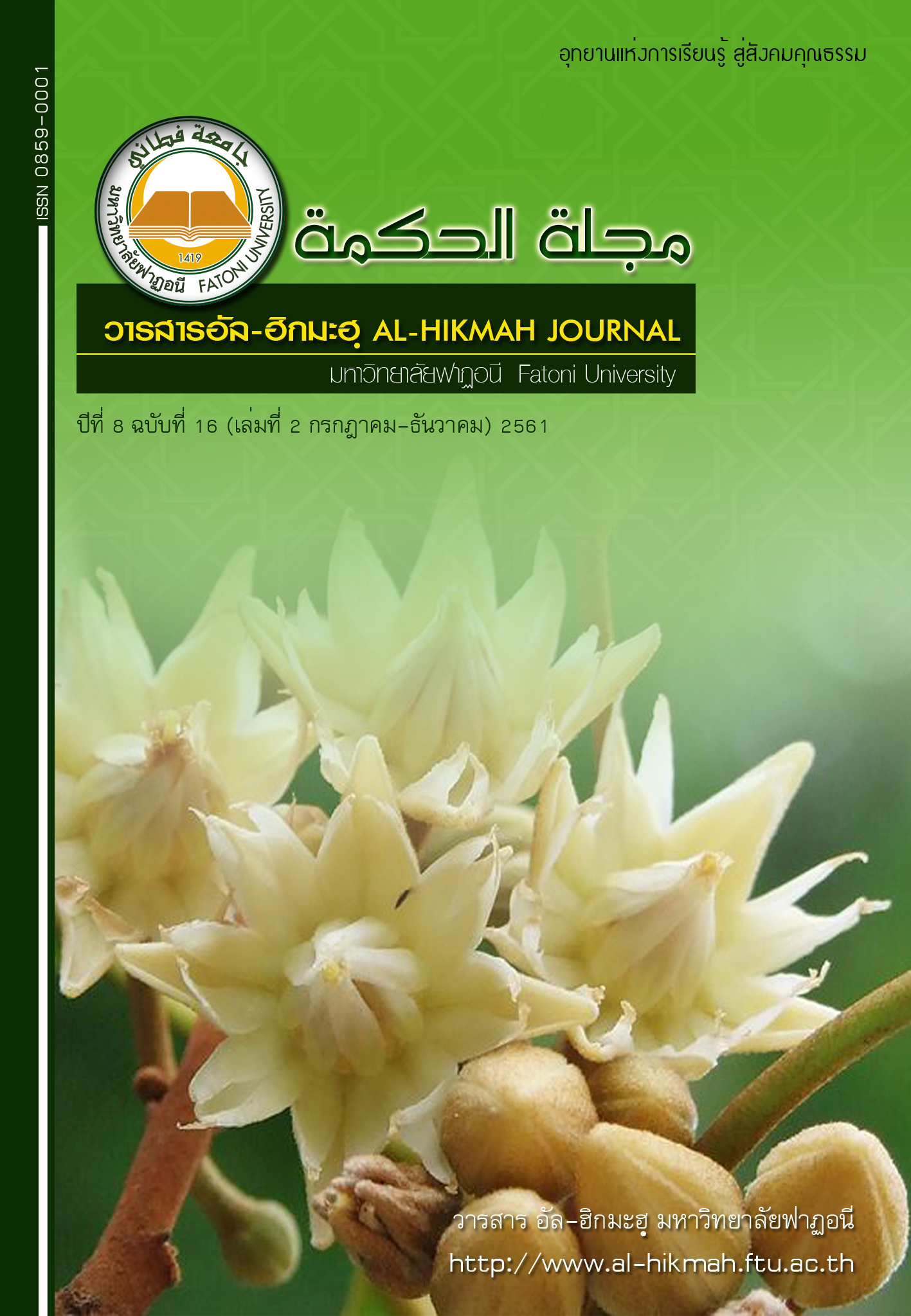ปัจจัยเชิงสาเหตุที่มีอิทธิพลต่อพฤติกรรมของลูกค้าในธุรกิจสปา ขนาดกลางและขนาดเล็กของไทย
Abstract
The research aims to (1) Study the causal factor influencing customer experience (2) Study the causal factor influencing customer behavior (3) Study the influencing customer experience to customer behavior. The researcher determined population in this research is SME spa service provider with interview, focus group include literature review to be synthesized as a research tool and questionnaire survey by the expert. Then the researcher selected spa in Bangkok Metropolis 50 subdivisions are answer from respondents to indication quality service provider. The researcher collected data by questionnaire between April to October 2015 and were used in the research consisted 400 samplings. The data were analyzed by Structural Equation Modeling (SEM)
The result show that the coreservice, servicescap and employee behavior have direct effect to customer experience.
The coreservice, servicescap and employee behavior have direct effect to customer behavior. Moreover customer experience has direct effect to customer behavior.
References
วิชิต อู่อ้น (2553) การวิเคราะห์และการสืบค้นข้อมูลทางธุรกิจ (พิมพ์ครั้งที่1) กรุงเทพฯ: มหาวิทยาลัยศรีปทุม
อรอนงค์ ภู่เจริญ และ วิชิต อู่อ้น (2560) ปัจจัยเชิงสาเหตุที่ส่งผลต่อพฤติกรรมการตัดสินใจซื้อสินค้าผ่านออนไลน์ของผู้บริโภค วารสารวิทยาลัยพาณิชยศาสตร์บูรพาปริทัศน์ 12(2)
Bitner, M.J.(1992) Servicescaps: The Impact of Physical Surrounding on Customers and Employees. Journal of Marketing.Vol.56 April.57-71.
Cronin, Jr., J.J. & Taylor, S. (1992). Measuring Service Quality: A Re-examination and Extension. Journal of Marketing. 56. 55–68
Chombunchoo, N. & U-On, V. (2016) The Competency and Innovative Work Behavior of Rajchapat University in Thailand. Middle-East Journal of Scientific Research 24 (5): 1594- 1599, 2016 ISSN 1990-9233.
Daunt, K.L., & Harris, L.C. (2011). Exploring the Form of Dysfunctional Customer Behavior: A Study of Differences in Servicescape and Customer Disaffection With Service. Journal of Marketing Management. Vol.28 No.1-2. 129-153.
Gable, R. K. (1986).Instrument Development in The Affective Domain. Boston: Kluwer-Nijhoff
Grage, R., Rahman, Z. & Qureshi, M.N. (2014). Measuring Customer Experience in Banks: Scale Development and Validation. Journal of Modelling in Management Vol. 9 No. 1 201487-117
Hair, J.F., Tatham, R.L., Anderson R.E. & Black, W. (1998). Multivariate Data Analysis 5th ed. Prentice-Hall. Upper Saddle River. NJ.
Hume, M., & Mort, G.S. (2010). The Consequence of Appraisal Emotion, Service Quality,Perceived Value and Customer Satisfaction on Repurchase Intent in the Performing Arts. Journal of Services Marketing.Vol.24.No.2. 170-182
Hightower, R. (2013). Investigating the Green Leadership in Energy and Environmental Design(LEED)Servicescape Scale in Brazil. Construction Innovation.Vol.13 No.3. 242-266.
Ismail, M.B.M., & Velnampy, T. (2013). Determinants of Patient Satisfaction (PS) In Public Health Service Organization(PHSO) In Eastern Province of Sri Lanka. The USV Annals of Economics and Public Administration. Volume 13. Issue 2(18). 135-145.
Ismail, A.R., Melewar, TC., Lim, L., & Woodside, A. (2011). Customer Experiences With Brands: Literature Review and Research Directions. The marketing review. Vol.11 No.3. 205-225
Lomax, R.G., & Schumacker, R.E. (1996).A Beginner’s Guide to Structural Equation Modeling. Mahwah. NJ: Lawrence Earlbaum.
Matula, P., & U-on, V. (2016) A Causal Relationship Model Work Engagement Affection Organizational Citizenship Behavior and Job Performance of Professional Nursing Middle-East Journal of Journal of Scientific Research (MEJSR) ISSN 1990-9233 Issue 5, Volume 24 Number (5), 2016, On-line Available issues
Oliver, R.L. (1980). A Cognitive Model of the Antecedents and Consequences of Satisfaction Decisions. Journal of Marketing Research. Vol. 17. 460-9.
Parasuraman, A., Zeithaml, V.A., & Berry, L.L (1988). SERVQUAL: A Multiple Item Scale for Measuring Consumer Perception of Service Quality. Journal of Retailing. Vol. 64 No. 1. 12-40.
Phan, C.A.& Nham, P.T. (2015). Impact of Service Quality on Customer Satisfaction of
Automated Teller Machine Service: Case Study of a Private Commercial Joint Stock Bank in Vietnam”. Business: Theory and Practice ,Vol 16 No3. 280-289.
Quoquab, F., Abdullah, N.L. & Mohammad J. (2016). Investigating The Effects of Consumer Innovativeness Service Quality and Service Switching Costs on Service Loyalty in the Mobile PhoneService Context. Gadjah Mada International Journal of Business.Vol.18 No.1. 21-53.
Sathish, A.S., & Venkatesakumar, R. (2011) Customer Experience Management and Store Loyalty in Corporate Retailing-with Special Reference to Sony World. Annamalai International Journal of Business Studies & Research . Vol. 3 Issue 1, 67-76.
Schmitt, B. (1999). Experiential Marketing. Journal of Marketing Management. 15-53.
Schmitt, B.(1992). Servicescapes: The Impact of Physical Surroundings on Customers and Employees. Journal of Marketing. Vol. 56, April. 57-71.
Suthinopparrattanakul, K., & U-on, V. (2016) .Model Development of Customer Relationship Management on Modern Trade. Universal Journal of Management ISSN: 2331-950X ISSN: 2331-9577 (online) Volume 4, Number 6, Horizon Research Publishing Corporation, USA
Sureshchandar, G.S., & Rajendran, C. (2001). Customer Perceptions of Service Quality: A Critique. Total Quality Management. Vol. 12 No. 1. 111-124.
Zeithaml, V.A., Berry, L.L, & Parasuraman, A. (1996). The Behavior Consequences of Service Quality. Journal of Marketing. Vol. 60. 31-46.



